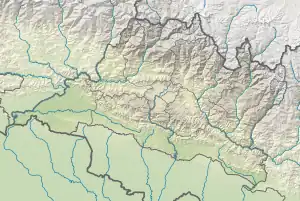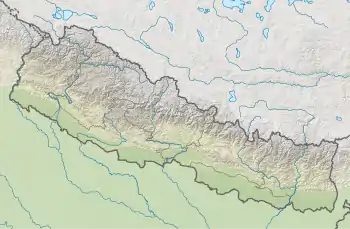Dhunibeshi Municipality
धुनीबेशी नगरपालिका | |
|---|---|
 Dhunibeshi Municipality Location of Municipality  Dhunibeshi Municipality Dhunibeshi Municipality (Nepal) | |
| Coordinates: 27°26′N 85°05′E / 27.43°N 85.09°E | |
| Country | Nepal |
| Province | Bagmati |
| District | Dhading |
| No. of wards | 9 |
| Established | 10 March 2017 |
| Incorporated (VDC) | Naubise, Chhatre Dyaurali, Jiwanpur |
| Government | |
| • Type | Mayor–council |
| • Body | Dhunibeshi Municipality Municipality |
| • Mayor | Balkrishna Acharya (CPN (US)) |
| • Deputy Mayor | Suraj Upreti NC |
| • MP & Constituency | Dhading 1 |
| • MLA & Constituency | Dhading 1(A) Rajendra Prasad Pandey (CPN (US)) |
| Area | |
| • Total | 96.30 km2 (37.18 sq mi) |
| Population (2011) | |
| • Total | 31,029 |
| Time zone | UTC+05:45 (NPT) |
| Website | dhunibeshimun |
Dhunibeshi is a municipality located within the Dhading District of the Bagmati Province of Nepal. The municipality spans 96.30 square kilometres (37.18 sq mi), with a total population of 31,029 according to a 2011 Nepal census.[1][2]
On March 10, 2017, the Government of Nepal restructured the local level bodies into 753 new local level structures.[3][4] The previous Naubise, Chhatre Dyaurali and Jiwanpur VDCs were merged to form Dhunibeshi. Dhunibeshi is divided into 9 wards, with Naubise declared the administrative center of the municipality.
Demographics
At the time of the 2011 Nepal census, Dhunibeshi Municipality had a population of 31,029. Of these, 77.1% spoke Nepali, 18.8% Tamang, 2.9% Newar, 0.3% Maithili, 0.2% Bhojpuri, 0.1% English, 0.1% Hindi, 0.1% Magar, 0.1% Tharu, 0.1% Urdu and 0.1% other languages as their first language.[5]
In terms of ethnicity/caste, 28.1% were Tamang, 24.3% Hill Brahmin, 21.3% Chhetri, 6.4% Newar, 4.5% Sarki, 3.0% Magar, 2.9% Rai, 2.1% Kami, 1.6% Damai/Dholi, 1.5% Sanyasi/Dasnami, 0.9% Gharti/Bhujel, 0.7% Danuwar, 0.7% Thakuri, 0.4% Musalman, 0.2% Chepang/Praja, 0.2% Tharu, 0.1% Bhote, 0.1% Gurung, 0.1% Hajam/Thakur, 0.1% Halwai, 0.1% Jirel, 0.1% Kalwar, 0.1% Kathabaniyan, 0.1% Teli, 0.1% Yadav and 0.3% others.[6]
In terms of religion, 81.0% were Hindu, 16.3% Buddhist, 2.1% Christian, 0.4% Muslim, 0.1% Prakriti and 0.1% others.[7]
References
- ↑ "District Corrected Last for RAJAPATRA" (PDF). www.mofald.gov.np. Retrieved 17 July 2018.
- ↑ "स्थानीय तहहरुको विवरण" [Details of the local level bodies]. www.mofald.gov.np/en (in Nepali). Ministry of Federal Affairs and Local Development. Retrieved 17 July 2018.
- ↑ "New local level structure comes into effect from today". www.thehimalayantimes.com. The Himalayan Times. 10 March 2017. Retrieved 17 July 2018.
- ↑ "New local level units come into existence". www.kathmandupost.ekantipur.com. 11 March 2017. Retrieved 18 July 2018.
- ↑ NepalMap Language
- ↑ NepalMap Caste
- ↑ NepalMap Religion
External links
